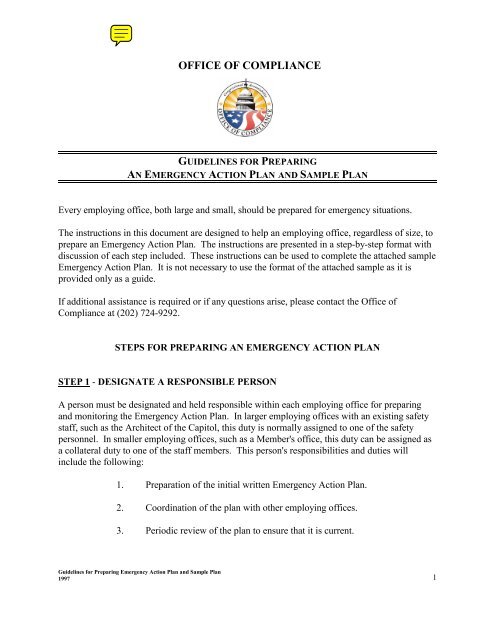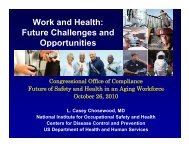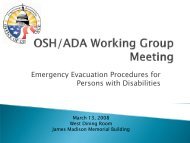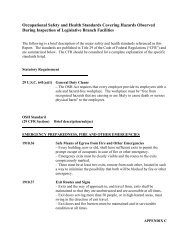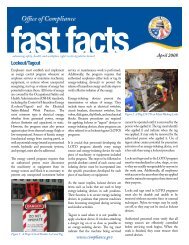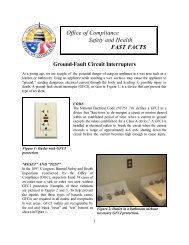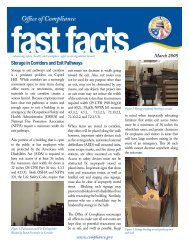Guidelines for Preparing an Emergency Action Plan and Sample Plan
Guidelines for Preparing an Emergency Action Plan and Sample Plan
Guidelines for Preparing an Emergency Action Plan and Sample Plan
Create successful ePaper yourself
Turn your PDF publications into a flip-book with our unique Google optimized e-Paper software.
OFFICE OF COMPLIANCEGUIDELINES FOR PREPARINGAN EMERGENCY ACTION PLAN AND SAMPLE PLANEvery employing office, both large <strong>an</strong>d small, should be prepared <strong>for</strong> emergency situations.The instructions in this document are designed to help <strong>an</strong> employing office, regardless of size, toprepare <strong>an</strong> <strong>Emergency</strong> <strong>Action</strong> Pl<strong>an</strong>. The instructions are presented in a step-by-step <strong>for</strong>mat withdiscussion of each step included. These instructions c<strong>an</strong> be used to complete the attached sample<strong>Emergency</strong> <strong>Action</strong> Pl<strong>an</strong>. It is not necessary to use the <strong>for</strong>mat of the attached sample as it isprovided only as a guide.If additional assist<strong>an</strong>ce is required or if <strong>an</strong>y questions arise, please contact the Office ofCompli<strong>an</strong>ce at (202) 724-9292.STEPS FOR PREPARING AN EMERGENCY ACTION PLANSTEP 1 - DESIGNATE A RESPONSIBLE PERSONA person must be designated <strong>an</strong>d held responsible within each employing office <strong>for</strong> preparing<strong>an</strong>d monitoring the <strong>Emergency</strong> <strong>Action</strong> Pl<strong>an</strong>. In larger employing offices with <strong>an</strong> existing safetystaff, such as the Architect of the Capitol, this duty is normally assigned to one of the safetypersonnel. In smaller employing offices, such as a Member's office, this duty c<strong>an</strong> be assigned asa collateral duty to one of the staff members. This person'sresponsibilities <strong>an</strong>d duties willinclude the following:1. Preparation of the initial written <strong>Emergency</strong> <strong>Action</strong> Pl<strong>an</strong>.2. Coordination of the pl<strong>an</strong> with other employing offices.3. Periodic review of the pl<strong>an</strong> to ensure that it is current.<strong>Guidelines</strong> <strong>for</strong> <strong>Preparing</strong> <strong>Emergency</strong> <strong>Action</strong> Pl<strong>an</strong> <strong>an</strong>d <strong>Sample</strong> Pl<strong>an</strong>1997 1
4. Periodic review of training requirements of the pl<strong>an</strong> to ensure that they arecurrently being met.5. Provide orientation <strong>for</strong> new employees in the requirements of the pl<strong>an</strong>.6. Periodic inspection of the area to ensure that exits are not blocked <strong>an</strong>d thatescape routes <strong>an</strong>d emergency telephone numbers are posted.STEP 2 - COORDINATE THE PLANAs <strong>an</strong>y employing office develops its <strong>Emergency</strong> <strong>Action</strong> Pl<strong>an</strong>, it must consider its relationshipswith other employing offices or org<strong>an</strong>izations which may affect portions of the pl<strong>an</strong>.Smaller employing offices, such as <strong>an</strong> individual Senator’s or Member's office, usually do nothave effective control of or responsibility <strong>for</strong> items such as the sprinkler system, smoke detectors,designating emergency numbers or designating building escape routes. These items are usuallywithin the control <strong>an</strong>d responsibility of the entities such as the Architect of the Capitol, whichhas overall superintendent responsibilities <strong>for</strong> the building. These smaller employing officesmust be aware of these items, however, <strong>an</strong>d properly include them in their pl<strong>an</strong>.Larger employing offices, such as the Architect of the Capitol, acting as the superintendent of thebuilding in which smaller employing offices are located, usually do not have <strong>an</strong>y control orresponsibility <strong>for</strong> items such as designating specific office exits or training new office employees.It is very import<strong>an</strong>t that the Architect of the Capitol (or other entity responsible <strong>for</strong> the overallemergency pl<strong>an</strong> <strong>for</strong> the building) <strong>an</strong>d the individual employing offices located in those buildingscoordinate their pl<strong>an</strong>s to ensure that the pl<strong>an</strong>s are in agreement. Further, some duplication ofef<strong>for</strong>t may be saved by coordinating items such as training.The Architect of the Capitol (or other entity responsible <strong>for</strong> the overall emergency pl<strong>an</strong> <strong>for</strong> thebuilding) should contact each of the individual employing offices in that building <strong>an</strong>d providethem with a copy of the master <strong>Emergency</strong> <strong>Action</strong> Pl<strong>an</strong> <strong>an</strong>d with specific instructions as to suchitems as the building evacuation routes <strong>an</strong>d appropriate emergency phone numbers.Individual employing offices should contact the Architect of the Capitol or other entityresponsible <strong>for</strong> superintendence of the building <strong>an</strong>d request in<strong>for</strong>mation on items such as alarmsystems, building evacuation routes <strong>an</strong>d appropriate emergency phone numbers.STEP 3 - FIRES (FIGHT OR FLEE)Determining all of the elements which must be included in your <strong>Emergency</strong> <strong>Action</strong> Pl<strong>an</strong> <strong>for</strong> fires<strong>Guidelines</strong> <strong>for</strong> <strong>Preparing</strong> <strong>Emergency</strong> <strong>Action</strong> Pl<strong>an</strong> <strong>an</strong>d <strong>Sample</strong> Pl<strong>an</strong>19972
will depend upon a basic decision as to what actions are expected from your employees. Thereare two options available.OPTION - 1TOTAL EVACUATIONUpon the discovery of a fire, <strong>an</strong> employing office may choose to have all its employeesevacuate the scene <strong>an</strong>d allow only professional fire fighting personnel attempt toextinguish the fire. If this option is selected, employees must be trained in methods ofreporting the fire, the fire alarm system, the proper evacuation routes <strong>an</strong>d as to theassembly area following evacuation.OPTION -2FIGHT THE FIREUpon the discovery of a fire, <strong>an</strong> employing office may choose to have certain, specificallytrained personnel attempt to extinguish small incipient stage fires. It is import<strong>an</strong>t to notethat all other personnel are expected to immediately evacuate, <strong>an</strong>d that the fire fighting inthis option is limited to very small, beginning fires. All other fire fighting should be leftto professional fire fighting personnel.For most employing offices, especially smaller employing offices located in office spaces, theGeneral Counsel recommends the option of total evacuation.STEP 4 - DESIGNATE EXIT ROUTESAll spaces occupied by employees or where employees c<strong>an</strong> reasonably be expected, such asstorage areas, should be surveyed to ensure that adequate me<strong>an</strong>s of emergency exit are available.In most cases, areas should be served by at least two separate routes of emergency exit. In some,small one room office spaces, a single route of exit may be acceptable. If there is <strong>an</strong>y question asto the acceptability of the routes of exit, contact the General Counsel’s Office <strong>for</strong> furtherguid<strong>an</strong>ce.Normally, the Architect of the Capitol will be responsible <strong>for</strong> the placement <strong>an</strong>d mainten<strong>an</strong>ce ofproper exit signs, <strong>an</strong>d <strong>for</strong> designating building exit routes. However, employing offices shouldperiodically check their assigned routes of exit to ensure that they are properly signed <strong>an</strong>d lead toa free <strong>an</strong>d unobstructed exit from the building. A simple way to check <strong>for</strong> proper signage is toexit the office space <strong>an</strong>d proceed to the nearest exit sign, <strong>an</strong>d then continue to follow the markedexits until the building is exited. If the exit signs do not lead to <strong>an</strong> obvious, unobstructed <strong>an</strong>dcontinuous path to building exit, they need to be corrected. This condition should immediatelybe reported to the Architect of the Capitol or other entity responsible <strong>for</strong> superintendence of thebuilding. Any <strong>an</strong>d all doors along the route of exit which could be mistaken <strong>for</strong> exit doors,should be clearly marked with a sign "NOT AN EXIT."<strong>Guidelines</strong> <strong>for</strong> <strong>Preparing</strong> <strong>Emergency</strong> <strong>Action</strong> Pl<strong>an</strong> <strong>an</strong>d <strong>Sample</strong> Pl<strong>an</strong>19973
Outside of normal business hours, some emergency exits may be locked <strong>for</strong> security purposes.When the normal exits are secured, alternate routes of exit must be designated. The Architect ofthe Capitol or other entity responsible <strong>for</strong> building superintendence is primarily responsible <strong>for</strong>ensuring that alternate me<strong>an</strong>s of exit are available, in<strong>for</strong>mation concerning these alternate exits iscommunicated to the employing offices in the building, <strong>an</strong>d that proper signage is in place to leadpersonnel to the available exits. Employing offices in those buildings are primarily responsible<strong>for</strong> ensuring that their employees are trained <strong>an</strong>d in<strong>for</strong>med about <strong>an</strong>y such alternate exits.STEP 5 - DESIGNATE THE ASSEMBLY AREAThe Architect of the Capitol or other entity responsible <strong>for</strong> building superintendence <strong>an</strong>demploying offices in the building should coordinate the selection of assembly areas to be used incase of <strong>an</strong> emergency.These areas should be located outside of buildings <strong>an</strong>d far enough from the building so thatemployees will not be exposed to <strong>an</strong>y further d<strong>an</strong>gers, <strong>an</strong>d so that they do not interfere with theactivities of emergency personnel, such as law en<strong>for</strong>cement or the fire department.All employees must be in<strong>for</strong>med of the assembly area.STEP 6 - DESIGNATE ADDITIONAL DUTIESIn addition to designating the person that will be responsible <strong>for</strong> the overall pl<strong>an</strong>, specific personsmust be designated <strong>for</strong> the following duties:REPORTING EMERGENCIES - Although all employees c<strong>an</strong> <strong>an</strong>d should immediatelyreport emergencies, persons should be designated to ensure that emergency personnel(such as law en<strong>for</strong>cement officials <strong>an</strong>d the fire department) have been contacted. Thesepersons will further be responsible <strong>for</strong> directing emergency personnel to the area of theemergency.ACCOUNTING FOR EMPLOYEES - Persons should be designated as responsible <strong>for</strong>accounting <strong>for</strong> all employees at the assembly area following evacuation of the work area.These persons should further be responsible <strong>for</strong> alerting emergency personnel to the lastknown location of <strong>an</strong>y missing employees.If applicable, specific persons should also be designated <strong>for</strong> the following duties:FIRST AID - Although there is no requirement that each employing office have first aidtrained personnel available, the General Counsel highly recommends it. For those<strong>Guidelines</strong> <strong>for</strong> <strong>Preparing</strong> <strong>Emergency</strong> <strong>Action</strong> Pl<strong>an</strong> <strong>an</strong>d <strong>Sample</strong> Pl<strong>an</strong>19974
employing offices with first aid trained personnel available, such personnel should beidentified to the other employees.CRITICAL OPERATIONS - The work area should be surveyed <strong>for</strong> critical operationswhich should be discontinued, if possible, be<strong>for</strong>e the area is evacuated. Such criticaloperations would include industrial operations which could help propagate a fire or areascontaining restricted materials. If such areas are identified, a person should be designatedto attempt to discontinue the operation or secure the areas with restricted materials.Under no circumst<strong>an</strong>ces should these persons end<strong>an</strong>ger <strong>an</strong>y person (or themselves)by entering a d<strong>an</strong>gerous area.STEP 7 - TRAININGTraining should be provided <strong>for</strong> all employees to adequately ensure the effectiveness of theprogram.GENERAL TRAINING - Upon employment <strong>an</strong>d at least <strong>an</strong>nually thereafter, allemployees should be trained in the general requirements of the pl<strong>an</strong> to include location ofthe master pl<strong>an</strong>, evacuation policy of the employing office, methods of emergencynotification, escape procedures <strong>an</strong>d exit routes, methods of reporting emergencies, <strong>an</strong>ddesignated assembly areas following evacuation.SPECIFIC TRAINING - Those employees assigned additional duties in the pl<strong>an</strong> shouldbe trained at least <strong>an</strong>nually in the requirements of these additional duties. This trainingshould include the following:REPORTING EMERGENCIES - Those individuals designated in the pl<strong>an</strong> asresponsible <strong>for</strong> ensuring that outside emergency personnel have been contactedshould be familiarized with all of the current emergency reporting numbers. Theyshould also be instructed as to their duties to coordinate with these outsideemergency personnel at the scene.ACCOUNTING FOR EMPLOYEES - Those individuals designated in the pl<strong>an</strong> asresponsible <strong>for</strong> ensuring <strong>an</strong> orderly evacuation, conducting a roll call ofemployees, <strong>an</strong>d reporting <strong>an</strong>y missing employees should be instructed as to theirduties.RESCUE AND FIRST AID - The first aid skills of <strong>an</strong>y person assigned to providesuch care should be updated <strong>an</strong>d certified at least <strong>an</strong>nually.FIRE FIGHTING DUTIES - If <strong>an</strong> employing office has decided to have certain<strong>Guidelines</strong> <strong>for</strong> <strong>Preparing</strong> <strong>Emergency</strong> <strong>Action</strong> Pl<strong>an</strong> <strong>an</strong>d <strong>Sample</strong> Pl<strong>an</strong>19975
persons operate fire extinguishers, those persons must be trained in the proper useof the extinguishers <strong>an</strong>d that training must be updated at least <strong>an</strong>nually.CRITICAL OPERATIONS - If <strong>an</strong> employing office has identified criticaloperations which are to be discontinued, if possible, during <strong>an</strong> emergency, thosepersons responsible <strong>for</strong> deactivating the operations should be trained in thosespecific operations <strong>an</strong>d those conditions when it will not be possible to deactivatethe operations.STEP 8 - PREPARE THE WRITTEN PLANNow that all the basic decisions concerning the pl<strong>an</strong> have been made <strong>an</strong>d all persons have beentrained, a written pl<strong>an</strong> should be prepared. The attached sample pl<strong>an</strong> may be used or <strong>an</strong>y other<strong>for</strong>m which contains all of the appropriate in<strong>for</strong>mation. A copy of the written pl<strong>an</strong> should beprovided to each employee.STEP 9 - POST ALL INFORMATIONAll appropriate in<strong>for</strong>mation should be prominently posted in the work areas. This in<strong>for</strong>mationshould include emergency numbers posted near each telephone, exits properly marked withsigns, <strong>an</strong>d diagrams of exit routes posted throughout the work areas.STEP 10 - PERIODIC REVIEWAt least <strong>an</strong>nually, the entire pl<strong>an</strong> should be reviewed to ensure that all in<strong>for</strong>mation contained in itis current <strong>an</strong>d accurate. The work areas should also be surveyed at this time to ensure that routesof exit are not blocked <strong>an</strong>d that all required in<strong>for</strong>mation is posted <strong>an</strong>d current. This <strong>an</strong>nualreview of the pl<strong>an</strong> is also <strong>an</strong> excellent time to ensure that all training is current.A <strong>Sample</strong> <strong>Emergency</strong> Pl<strong>an</strong> follows.<strong>Guidelines</strong> <strong>for</strong> <strong>Preparing</strong> <strong>Emergency</strong> <strong>Action</strong> Pl<strong>an</strong> <strong>an</strong>d <strong>Sample</strong> Pl<strong>an</strong>19976
SAMPLE EMERGENCY ACTION PLAN[Note: This sample <strong>Emergency</strong> <strong>Action</strong> Pl<strong>an</strong> is intended as a guide to assist employing offices inpreparing a pl<strong>an</strong> appropriate to their size <strong>an</strong>d situation. It is not necessary that employing officesuse the <strong>for</strong>mat of this sample, so long as the pl<strong>an</strong> contains the elements described above]Employing Office or org<strong>an</strong>ization nameLocationCity State Zip CodePrepared by:Name of preparerTitleAddress/LocationPhone numberSignatureDate<strong>Guidelines</strong> <strong>for</strong> <strong>Preparing</strong> <strong>Emergency</strong> <strong>Action</strong> Pl<strong>an</strong> <strong>an</strong>d <strong>Sample</strong> Pl<strong>an</strong>19977
PURPOSEThis pl<strong>an</strong> is <strong>for</strong> the safety <strong>an</strong>d well-being of the employees of [Name of Employing Office ororg<strong>an</strong>ization]. It identifies necessary m<strong>an</strong>agement <strong>an</strong>d employee actions during fires <strong>an</strong>d otheremergencies. Education <strong>an</strong>d training are provided so that all employees know <strong>an</strong>d underst<strong>an</strong>d the<strong>Emergency</strong> <strong>Action</strong> Pl<strong>an</strong>.LOCATION OF PLANEach employee of this office has been provided with a copy of this pl<strong>an</strong>. A copy will also bemaintained at [Location of master copy].Any questions concerning this pl<strong>an</strong> should be directed to [Name <strong>an</strong>d telephone number of personresponsible <strong>for</strong> the pl<strong>an</strong>].EMERGENCY POLICYIt is the policy of this office that all employees should evacuate the premises in case of fire orother emergency.ALARM SYSTEMS AND NOTIFICATION OF EMERGENCIESIn <strong>an</strong> emergency, employees will be notified by [method of notification]. This system shouldprovide warning <strong>for</strong> necessary emergency action <strong>an</strong>d sufficient time <strong>for</strong> safe escape of employeesfrom the workplace.<strong>Guidelines</strong> <strong>for</strong> <strong>Preparing</strong> <strong>Emergency</strong> <strong>Action</strong> Pl<strong>an</strong> <strong>an</strong>d <strong>Sample</strong> Pl<strong>an</strong>19978
ESCAPE PROCEDURES AND EXIT ROUTESAll exits will remain unlocked <strong>an</strong>d unobstructed during working hours. Allemployees must exit the facility in a quiet <strong>an</strong>d orderly m<strong>an</strong>ner.The following employees must leave through EXIT 1:The following employees must leave through EXIT 2:The following employees must leave through EXIT 3: [If applicable]Diagrams of the various exit routes will be posted prominently in the work areas <strong>an</strong>d are attachedto this pl<strong>an</strong>.<strong>Guidelines</strong> <strong>for</strong> <strong>Preparing</strong> <strong>Emergency</strong> <strong>Action</strong> Pl<strong>an</strong> <strong>an</strong>d <strong>Sample</strong> Pl<strong>an</strong>19979
REPORTING EMERGENCIESAny employee, upon discovering <strong>an</strong> emergency situation, shall immediately notify otheremployees in the area of the situation <strong>an</strong>d sound <strong>an</strong> appropriate alarm. As soon as safetypossible, the situation shall be reported to the appropriate outside emergency personnel asfollows:Type of emergency Contact Phone numberFireBomb threatMedical emergencyElectricalOther safety or health hazardsThese emergency numbers shall be prominently posted near each telephone.Within this office, the following personnel have the duty to insure that outside emergencypersonnel have been contacted. They are also responsible <strong>for</strong> coordinating with outsideemergency personnel on the scene <strong>an</strong>d provide directions to the site of the emergency. Thesepersonnel are listed in descending order of availability:1.Name <strong>an</strong>d titlePhone number2.Name <strong>an</strong>d titlePhone number3.Name <strong>an</strong>d titlePhone number<strong>Guidelines</strong> <strong>for</strong> <strong>Preparing</strong> <strong>Emergency</strong> <strong>Action</strong> Pl<strong>an</strong> <strong>an</strong>d <strong>Sample</strong> Pl<strong>an</strong>199710
ACCOUNTING FOR EMPLOYEESAfter exiting the facility, all employees are to assemble <strong>for</strong> roll call at [Location of assemblyarea].The following employees are responsible <strong>for</strong> ensuring that employees comply with thisrequirement, conducting the roll call <strong>an</strong>d reporting to outside emergency personnel the lastknown location of <strong>an</strong>y missing employees. These responsible employees are listed in descendingorder of availability:1.Name <strong>an</strong>d title2.Name <strong>an</strong>d title3.Name <strong>an</strong>d titleRESCUE AND MEDICAL DUTIESThe following personnel are trained <strong>an</strong>d certified in both CPR <strong>an</strong>d general first aid. In case ofmedical emergency, they are available to assist until the outside emergency personnel reach thescene.Name <strong>an</strong>d titlePhone numberName <strong>an</strong>d titlePhone numberName <strong>an</strong>d titlePhone number<strong>Guidelines</strong> <strong>for</strong> <strong>Preparing</strong> <strong>Emergency</strong> <strong>Action</strong> Pl<strong>an</strong> <strong>an</strong>d <strong>Sample</strong> Pl<strong>an</strong>199711
CRITICAL OPERATIONSIn order to minimize the d<strong>an</strong>ger or damage from a fire or other emergency, this office hasdetermined that certain critical operations should be shut down immediately. The followingpersonnel are responsible <strong>for</strong> shutting down the listed critical operations:Names of PersonnelCritical Operation(s)FURTHER INFORMATIONAny questions, comments or suggestions <strong>for</strong> improvement in this pl<strong>an</strong> should be directed to thefollowing personnel:1.2.3.Name <strong>an</strong>d titleName <strong>an</strong>d titleName <strong>an</strong>d titlePhone numberPhone numberPhone number<strong>Guidelines</strong> <strong>for</strong> <strong>Preparing</strong> <strong>Emergency</strong> <strong>Action</strong> Pl<strong>an</strong> <strong>an</strong>d <strong>Sample</strong> Pl<strong>an</strong>199712


